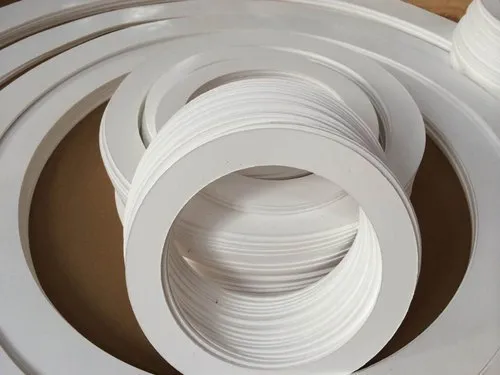What is ePTFE?
It's a synthetic plastic that incorporates all of the features of PTFE while also adding a new set of mechanically improved attributes. That means expanded PTFE operates across a wide range of service temperatures and can shrug off caustic fluid attacks, as imposed by some of mankind's harshest chemical mediums. On top of that, the plastic is more rubber-like, more conformable and seal-pliable. It goes without saying, but let's say it anyway; these are the physical attributes that attract the gasketing industry. Resistant to high pressures, high and low temperatures, and material eroding chemicals, PTFE is a desirable gasket medium. Expanded PTFE, on the other hand, retains all of the above features, then it adds mechanical flexibility to an already attractive package.
Expanded PTFE: Uses and Applications
First and foremost, the conformable plastic finds itself die-cut into rings and seated against large flange faces. Heavy-duty bolts and nuts are tightened in special patterns so that installer-imposed compressive forces surround a seal and pipe cavity. The point being, ePTFE can endure the highest imaginable compressive energies, yet gaskets made from this flexible fluoroelastomer seal won't crack under the pressure. Creep and blowout impervious, too, the gaskets can contain high-pressure fluid streams. Because of these features, expect to find ePTFE gaskets used in the kind of applications that employ continual thermal cycling. In oil refineries and chemical processing plants, in cryogenics facilities and heat exchanger usage areas, the seals cope with high-to-low temperature transients. Low-to-high thermal variances are similarly tolerated.
If that last sentence doesn’t quite make sense, imagine an active equipment line. Pressure vessels are storing a caustic medium in here. That substance is hot and being held at high pressure. Now, many gasket materials can tolerate one or two of those energetic threats. ePTFE can tolerate all of these threats. Even pressed down hard by two flange faces, the expanded PTFE holds firm. Better yet, though, if the system using the gaskets executes some kind of a phase change, one that changes the processing temperature or storage pressure, then the gaskets won’t suffer. Free of creep, strong and reliable, the fluoroelastomer withstands application and process transients.
The Difference between PTFE and Expanded PTFE
Introduction
PTFE stands for Polytetrafluoroethylene. It is a synthetic fluoropolymer of tetrafluoroethylene. Expanded PTFE is made of 100% pure PTFE which can be used as a sealing agent. It is lightweight but strong. These materials are used for various industrial applications but you should know whether PTFE or ePTFE is better for your application. To get the answer to this crucial question you must know the difference between and usages of these two materials.
PTFE:
- PTFE or Teflon is a solid material.
- It can function well in an environment with up to 260 Degree Celsius temperature.
- It is a long-lasting material as it can put up with corrosion.
- It does not cause much friction.
- The industries fit for the usage of PTFE are oxidizing media, mineral oils, pharmaceutical, food, petrochemicals, glass line reactors and columns, solvents, lacquers, and corrosive chemicals.
- It does not contaminate anything that comes in close proximity to it as it is non-corrosive which is why food industries use it.
- It has no smell of its own.
ePTFE:
- 100%virgin PTFE is the material used to produce expanded PTFE.
- ePTFE as a sealing material can be highly compressed.
- It can stand strong against creep and cold flow.
- It can adapt to sealing surfaces easily.
- It can be modified as per requirements such as surface energies, stiffness, hardness, etc.
- It is microporous and so fit for any task that needs airflow.
- It stretches at a high temperature and is smooth in texture.
- It is chemically inactive, water-resistant at low pressure, UV resistant and has a low dielectric constant, radial extension, divergent porosity level.
- It can be used in medical and biological industries, high-performance filters, medical devices, oil and gas industries, electronic insulators, hernia repair, vascular grafts, and other reconstructive surgery, fluidic purification applications, and environmental filtration.
Both PTFE and ePTFE have superb industrial applications with excellent features. But the range of application of ePTFE is wider than PTFE. The multi-directional fibrous structure of ePTFE makes it capable of performing at a high surface pressure condition. For maximum safety demands like flange sealing of oxygen-carrying tubes, ePTFE is the appropriate material as it can be highly customized. ePTFE has a better performance rate than PTFE. It has so much demand in the market that it is now manufactured with varying heights, densities, and dimensions.

